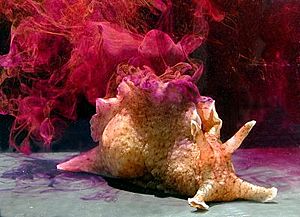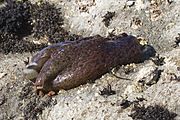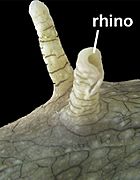California sea hare facts for kids
Quick facts for kids California sea hare |
|
|---|---|
 |
|
| Releasing ink after being disturbed | |
| Scientific classification | |
| Genus: |
Aplysia
|
| Species: |
californica
|
 |
|
| Occurrence is sparse in the northern portion of this range | |
| Synonyms | |
|
Aplysia nettiae Winkler, 1959 |
|
The California sea hare (Aplysia californica) is a type of sea slug. It belongs to the sea hare family, Aplysiidae. You can find it in the Pacific Ocean, especially off the coast of California in the United States and northwestern Mexico.
Contents
Where They Live
The California sea hare lives along the coast of California, USA, and northwestern Mexico. This includes the Gulf of California. These sea slugs usually live in shallow waters where sunlight can reach. This allows them to eat algae. They are often found in areas where the tide goes in and out, usually not deeper than about 18 to 20 meters (about 60-65 feet).
What They Look Like
The California sea hare can grow quite large. The longest one ever recorded was about 75 centimeters (30 inches) when it was fully stretched out. However, most adult sea hares are usually half that size or even smaller. Adult animals can weigh up to 7 kilograms (about 15 pounds). There is a similar species, the black sea hare (Aplysia vaccaria), which can grow even bigger.
Life Cycle of a Sea Hare
Like all sea hares, the California sea hare is a hermaphrodite. This means it acts as both a male and a female at the same time when it mates. Aplysia are known to form long mating chains. These chains can have up to 20 animals joined together.
Their eggs are yellow-green when first laid. After about 8 to 9 days, they turn brown before the tiny larvae hatch. Mating happens most often during the summer months. This is when the water temperature rises to about 17 degrees Celsius (63 degrees Fahrenheit).
A sea hare's life cycle from egg to adult takes about 19 weeks.
- Days 1-37: They are tiny larvae floating in the water.
- Days 34-37: They start to change into their adult form.
- Days 45-80: They are young sea hares.
- Day 85: They are old enough to reproduce.
Their nervous system takes about 140 days to fully develop. Most sea hares live for about a year. However, some older animals have been found. Cooler water temperatures can make them lay eggs later. This can also help them live longer.
-
Out of water at low tide near Morro Bay
What They Eat
The California sea hare is a herbivore. This means it only eats plants, mainly algae. Its diet mostly includes red algae like Laurencia pacifica, Plocamium pacificum, and Ceramium eatonianum. Eating these algae gives the sea hare its typical reddish or pinkish color. The sea hare often looks very similar to the seaweed it eats. This makes it hard to spot unless it is moving.
Who Eats Them?
The California sea hare has very few animals that hunt it. This is because it has toxins in its body. These toxins come from the algae it eats. Some animals that might eat young sea hares include starfish, lobsters, and another sea slug called Navanax inermis.
When a sea hare feels very threatened, it can release two different kinds of ink. These inks come from different parts inside its body. One ink is reddish-purple. It comes from a part called the purple ink gland. The other ink is milky white. It comes from a part called the opaline gland and contains a chemical called opaline.
How They Protect Themselves
Releasing ink helps protect the sea hare from predators like spiny lobsters. It does this in three ways:
- Chemical defense: The sea hare releases chemicals that taste bad or are harmful to predators. This quickly makes the predator stop trying to eat it.
- Confusing senses: The ink creates a dark cloud in the water. This acts like a smoke screen. It makes it hard for the predator to see or sense the sea hare.
- Fake food: The opaline chemical affects the predator's feeding senses. It makes the predator think the cloud of chemicals is actually food. So, the predator attacks the ink cloud instead of the sea hare.
Used in Science
The California sea hare has become a very important animal for scientific studies. Scientists use it to study the nervous system, especially how learning and memory work. It is famously linked to the work of Nobel Laureate Eric Kandel.
Scientists like to use the California sea hare because its nervous system is simple. It has only about 20,000 large neurons. These neurons are easy to find, and their cell bodies can be up to 1 millimeter in size. Even with a simple nervous system, the sea hare can learn many things. This includes learning to react more strongly to something (sensitization) or less strongly (habituation). It can also learn through classical and operant conditioning. Often, studies focus on its gill and siphon withdrawal reflex.
In March 2005, scientists decided it was important to sequence the sea hare's entire genetic code. A draft of its genetic code is available online for scientists to study.
Images for kids
See also
 In Spanish: Babosa marina borracha para niños
In Spanish: Babosa marina borracha para niños





